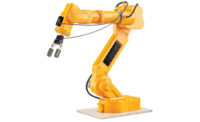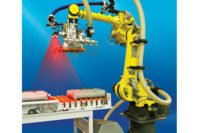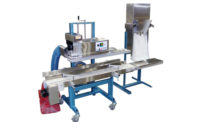More bakers and snack producers are using robotic equipment to pick, pack and palletize their ever-growing product offerings. Equipment manufacturers are, therefore, developing robots with higher speeds, simpler interfaces, better sanitation and enhanced robotic vision for these customers.
Equipment sanitation and unified controls are two key initiatives in the development of robotic equipment for the bakery and snack food industries, according to Dean Elkins, senior general manager, Yaskawa America Inc., Motoman Robotics Division, Miamisburg, OH. “Food-processing companies are striving to be compliant with food-safety standards,” he says. “In response, robots are being manufactured to utilize food-grade grease to minimize potential food contamination.
“Also, robot controls are being embedded as part of an overall line control scheme,” continues Elkins. “There is a growing desire to allow robots to be programmed as a part of the machine or cell controller rather than as a standalone device.” To that end, his company has designed a robot interface that allows the user to program the robot in easy-to-use function blocks. “This means that employees do not need to learn a proprietary language to operate robots,” he says.
Earl Wohlrab, palletizing and robotic systems product manager, Intelligrated, Mason, OH, cites the fragile nature of a product and its packaging—most notably balancing throughput rates and packaging type—as a challenge for bakeries and snack producers. High changeover rates is another, he says, explaining that while a single line may run a specific product, that product may be packaged in sizes ranging from 1 ounce to 5 pounds.
The latest advances are in robotic systems are designed to overcome these challenges. In recent years, these systems have been used for handling solid products like hard cookies, which are not affected by the robot’s end effector. “As end-effector technology and vision systems continue to advance to keep up with changing food-processing demands, the latest robotic systems are capable of handling soft products, such as muffins or baked goods, as well,” says Paul Garms, marketing manager, Bosch Packaging Technology, Farmington Hills, MI.
Beyond packaging
Besides packaging capabilities, bakers and snack food producers are seeking high-speed, food-ready robots that can perform tasks such as bread scoring and cake decoration. “To accomplish this, the latest robots use food-grade lubricants, have washdown capabilities and are able to withstand harsh cleaning chemicals,” says L.P. Musunur, manager of picking, packing and palletizing segment, Fanuc Robotics America Inc., Rochester Hills, MI.
Unifiller Systems Inc., Delta, British Columbia, has seen increased demand for robotic technology to produce intricate cake decorations that look handmade, says Stewart MacPherson, vice president of sales and marketing for the company. “Our robotic systems can write ‘Happy Birthday’ at high speed on moving cakes and apply multicolored frosting on cupcakes.”
Different cake heights present a challenge to bakers attempting to automate the decorating process. “We solved this challenge by incorporating 3-D scanning via laser sensors that monitor and provide instant feedback to the robot, which in turn adjusts the height of the decorating tips across the surface of the cakes’ target area,” explains MacPherson.
Many robotic systems are self-monitoring, which means they can analyze errors and provide troubleshooting tips. “Most systems have a two-tiered error messaging logic,” says Wohlrab. “The robot reports on itself to the system PLC/PC, and system-level error reporting is made to the operator through a human-machine interface (HMI). The robot then sends error messaging to a teach pendant.”
Some robotic systems have force-sensing software and hardware that allows them to “feel” the fit of close-tolerance parts and assemble them, according to John French, vice president of projects and applications, BluePrint Automation Inc., Colonial Heights, VA. “The software driving the robots has gotten extremely user-friendly and can be monitored from a smartphone,” he says. “Gone are the days of programming hard-core code; most tasks can be handled with graphic interfaces (e.g., Windows) that are fairly intuitive to most operators and maintenance staff.”
Many robots also come equipped with software that helps with monitoring and troubleshooting tasks. For example, the latest software allows operators to prepare formulas and production processes offline and simulate runs, helping reduce setup time for new batches and spot errors before actual production starts. Garms notes that his company provides software that offers a 3-D visualization of robotic movements. “It provides operators with the view seen by the vision system, positioning them to better troubleshoot issues,” he says.
A new level of automation
Vision-guided robotics is another feature common on many systems. Robots routinely use products that allow them to determine product orientation, notes Elkins. “The vision system sends image data to the robot controller, allowing it to modify its programmed path to accurately locate objects that might be placed randomly on a conveyor or rotated randomly when exiting a machine,” he says.
New vision system and control software can even determine the exact coordinates of food components spread out randomly beneath the camera’s field of vision, enabling the robot arm to move to a selected component and pick it from the conveyor belt. French notes that his company offers vision-guided robotics for stacking, wrapper loading, variety packing, dinner tray loading and kit assembly applications.
Colborne Foodbotics, Lake Forest, IL, recently introduced high-speed picking and packing in a single pan-to-package movement, according to Rick Hoskins, director of sales and marketing for the company. “In the early 2000s, we noticed a drop in the price of robots and increased reliability,” he says. “So we began redesigning our systems to integrated robotics and have since added features that are powered through the robot and take automation to a new level.”
The integrated systems are designed to handle different packaging schemes with no changeover adjustment required on the main conveyor. They feature various sensor upgrades to minimize line stoppage due to pan jams and can load complex party-platter trays into nonlinear arrays. In addition, they’re simple to start and operate by one person.
Focke & Co. Inc., Whitsett, NC, offers a wide range of robotic equipment that accommodates setups for different weights, speeds and products, according to Johann Betschart, vice president operations for the company. “This technology is well-suited to package pillow bags, gusseted bags in standard cases, trays or shelf-ready containers,” he says. For example, for a product that requires unique case collations, the platform can side- and top-load on the same containers, he notes. And since it’s a modular platform, it’s easy to adjust the layout for systems to fit into existing production lines.
Developments in robotic technology have taken off in recent years, as end users have become more accepting of the technology. They realize that robotics is not mysterious, complicated or overly expensive, French says. “This has allowed suppliers and integrators to really branch out from an applications perspective and consider using robotics for tasks outside the norm,” he adds. “We anticipate seeing additional robotic enhancements for food processors in the near future.”






